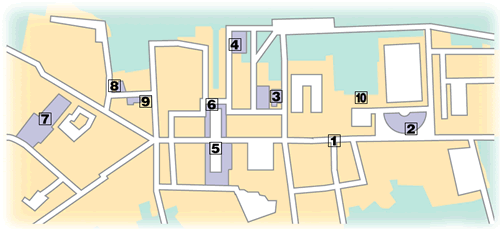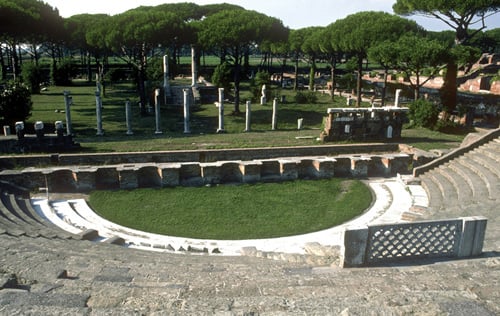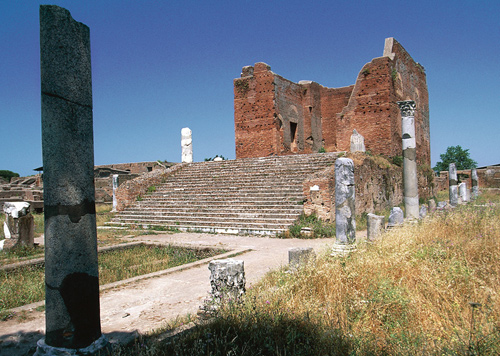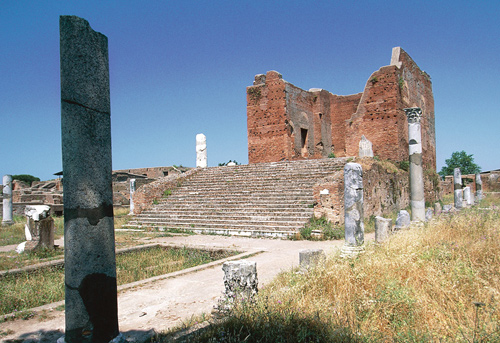Some 2,000 years ago, ancient Rome’s lively international port city was right on the beach and at the mouth of the Tiber (ostium
means “river mouth”). In the ensuing millennia the sea has retreated
several kilometres and the river has changed course dramatically. Ostia
was founded in the 4th century BC, first as a simple fort, but as Rome
grew, the town became ever more important, as the distribution point for
imports from around the Mediterranean. Grain was the most vital
commodity, to feed Rome’s one million inhabitants, and so huge storage
bins (horrea)
were built here. Goods were sent up to Rome on river barges. Ostia’s
heyday ended in the 4th century AD, and it died completely as an
inhabited area about 1,000 years ago.
Viale dei Romagnoli 717 Metro B, trams 3 and 30, or buses 23, 95, 75, 280 to Piramide, then local train from Porta San Paolo Station to Ostia Antica 06 5635 8099 Open Nov–Feb: 8:30am–5pm daily; Mar: 8:30am–6pm daily; Apr–Oct: 8:30am–7:30pm daily, closed 1 Jan, 25 Dec, 1 May Adm €6.00 (reduced €3.00) The port area (Trajan’s Port) can be visited on request 06 6501 0089
|
|
Arrival by local train is
very easy, and takes about 20 minutes from Porta San Paolo station, next
to the Piramide underground stop. The cost of the trip is one regular
bus ticket. From the Ostia Antica train station, walk straight out to
the footbridge that goes over the highway. Continue straight on past the
restaurant until you get to the ticket booth. The park is very
extensive and a decent visit will take at least three hours. Wear sturdy
shoes, and bring sunscreen and a bottle of water on hot days.
|

Ostia Antica
|
There’s a snack bar behind the museum, which is a great place to refuel and refresh on a hot day.
|
|
|
The ruined walls can look confusingly similar, so rent one of the audio guides where you buy your entrance ticket.
|
|
Top 10 FeaturesDecumanus Maximus You
enter the park by way of the ancient Via Ostiensis. The white marble
goddess on the left marks the beginning of city’s main street, the
Decumanus Maximus). Theatre The
original theatre was twice as tall as it now stands. Behind the stage
was a temple, of either Ceres (goddess of grain) or Dionysus (god of
theatre). Around the square, mosaics) advertise various import
businesses: grain, wild animals, ivory and shipping.

Casa di Diana and Thermopolium You can climb up to the top of this insula (apartment block) for a great view. Across the street is the Thermopolium, a tavern with a wall-painting of menu items. Museum Beautifully
organized, the displays include precious sculptures, sarcophagi and
mosaics found among the ruins. One of the highlights is a marble statue
of the god Mithras about to sacrifice the Cosmic Bull. Forum The
rectangular heart of officialdom was originally surrounded by columns.
In the centre was a shrine to the Imperial Lares (household gods).

Forum
Capitolium Dominating
the city was the monumental temple to the Capitoline Triad – Jupiter,
Juno and Minerva. Climb the staircase to examine the threshold stone of
rare Lucullan marble.

Terme dei Sette Sapienti This
elaborate bath complex contains a painting of Venus, floor mosaics of
hunters and animals and nude athletes and marine scenes. House of Cupid and Psyche The wealthy had villas like this refined example of a 3rd-century AD domus. You can still admire the Doric columns, the fountain (nymphaeum) and the inlaid marble decorations. Terme di Nettuno Built
in the 2nd century, this bath complex was enhanced with fine mosaics of
sea-gods and sea-monsters, which you can view from a small terrace. You
can also go down along to the left to study close-up the baths’
ingenious heating system. Mithraeum of the Serpents This
was one of 18 Ostian temples to Mithras. The cult was very popular with
Roman soldiers, and flourished especially well in port towns. The
frescoes of snakes invoked the earth’s fertility, while the platforms
were for lying on during mystic banquets.
|